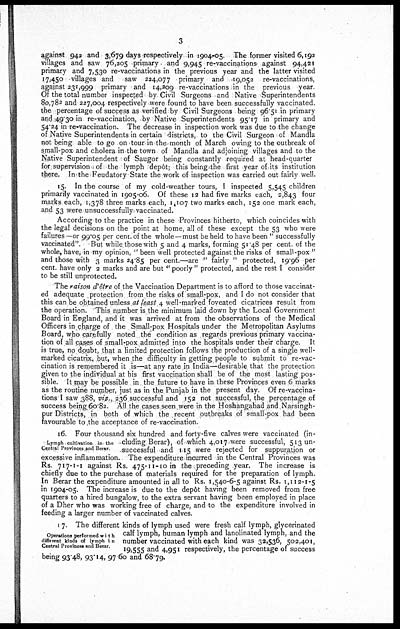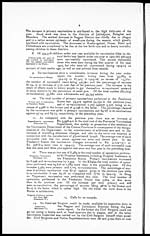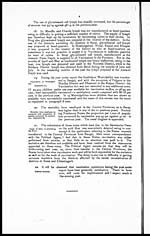Medicine - Vaccination > 1868-1929 - Report on the vaccine operations in the Central Provinces > Vaccine operations Central Provinces 1900-1911 > 1905-1906 - Notes on vaccination in the Central Provinces for the season 1905-06
(246) Page 3
Download files
Individual page:
Thumbnail gallery: Grid view | List view

3
against 942 and 3,679 days respectively in 1904-05. The former visited 6,192
villages and saw 76,205 primary and 9,945 re-vaccinations against 94,421
primary and 7,530 re-vaccinations in the previous year and the latter visited
17,450 villages and saw 224,077 primary and 19,052 re-vaccinations,
against 231,999 primary and 14,209 re-vaccinations in the previous year
Of the total number inspected by Civil Surgeons and Native Superintendents
80,782 and 227,004 respectively were found to have been successfully vaccinated,
the percentage of success as verified by Civil Surgeons being 96.51 in primary
and 49.30 in re-vaccination, by Native Superintendents 95.17 in primary and
54.24 in re-vaccination. The decrease in inspection work was due to the change
of Native Superintendents in certain districts, to the Civil Surgeon of Mandla
not being able to go on tour in the month of March owing to the outbreak of
small-pox and cholera in the town of Mandla and adjoining villages and to the
Native Superintendent of Saugor being constantly required at head-quarter
for supervision of the lymph depôt; this being the first year of its institution
there. In the Feudatory State the work of inspection was carried out fairly well.
15. In the course of my cold-weather tours, I inspected 5,545 children
primarily vaccinated in 1905-06. Of these 12 had five marks each, 2,843 four
marks each, 1,378 three marks each, 1,107 two marks each, 152 one mark each,
and 53 were unsuccessfully vaccinated.
According to the practice in these Provinces hitherto, which coincides with
the legal decisions on the point at home, all of these except the 53 who were
failures —or 99.05 per cent. of the whole—must be held to have been " successfully
vaccinated". But while those with 5 and 4 marks, forming 51.48 per cent of the
whole, have, in my opinion, " been well protected against the risks of small-pox "
and those with 3 marks 24.85 per cent.—are " fairly" protected, 19.96 per
cent. have only 2 marks and are but " poorly " protected, and the rest I consider
to be still unprotected.
The raison d'être of the Vaccination Department is to afford to those vaccinat-
ed adequate protection from the risks of small-pox, and I do not consider that
this can be obtained unless at least 4 well-marked foveated cicatrices result from
the operation. This number is the minimum laid down by the Local Government
Board in England, and it was arrived at from the observations of the Medical
Officers in charge of the Small-pox Hospitals under the Metropolitan Asylums
Board, who carefully noted the condition as regards previous primary vaccina-
tion of all cases of small-pox admitted into the hospitals under their charge. It
is true, no doubt, that a limited protection follows the production of a single well-
marked cicatrix, but, when the difficulty in getting people to submit to re-vac-
cination is remembered it is—at any rate in India—desirable that the protection
given to the individual at his first vaccination shall be of the most lasting pos-
sible. It may be possible in the future to have in these Provinces even 6 marks
as the routine number, just as in the Punjab in the present day. Of re-vaccina-
tions I saw 388, viz., 236 successful and 152 not successful, the percentage of
success being 60.82. All the cases seen were in the Hoshangabad and Narsingh-
pur Districts, in both of which the recent outbreaks of small-pox had been
favourable to the acceptance of re-vaccination.
Lymph cultivation in the
Central Provinces and Berar
16. Four thousand six hundred and forty-five calves were vaccinated (in-
cluding Berar), of which 4,017 were successful, 513 un-
successful and 115 were rejected for suppuration or
excessive inflammation. The expenditure incurred in the Central Provinces was
Rs. 717-1-1 against Rs. 475-11-10 in the preceding year. The increase is
chiefly due to the purchase of materials required for the preparation of lymph.
In Berar the expenditure amounted in all to Rs. 1,540-6-5 against Rs. 1,112-1-5
in 1904-05. The increase is due to the depôt having been removed from free
quarters to a hired bungalow, to the extra servant having been employed in place
of a Dher who was working free of charge, and to the expenditure involved in
feeding a larger number of vaccinated calves.
Operations performed with
different kinds of lymph in
Central Provinces and Berar
17. The different kinds of lymph used were fresh calf lymph, glycerinated
calf lymph, human lymph and lanolinated lymph, and the
number vaccinated with each kind was 32,536, 502,401,
19,555 and 4,951 respectively, the percentage of success
being 93.48, 93.14, 97.60 and 68.79.
Set display mode to: Large image | Zoom image | Transcription
Images and transcriptions on this page, including medium image downloads, may be used under the Creative Commons Attribution 4.0 International Licence unless otherwise stated. ![]()
| Permanent URL | https://digital.nls.uk/91521005 |
|---|
| Attribution and copyright: |
|
|---|




